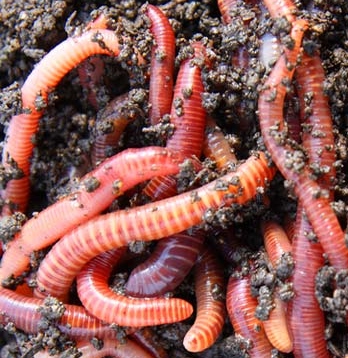Utilizing Red Wigglers for Reliable Organic Waste Disposal
The usage of red wigglers for organic garbage disposal offers an engaging strategy to handling food scraps while advertising environmental sustainability. These worms not just improve waste decomposition but additionally produce important worm castings, which can significantly improve dirt health and wellness. Their ability to process large volumes of natural product with minimal initiative positions them as an available remedy for homes and areas alike. Nonetheless, understanding the nuances of establishing a successful worm container and keeping an ideal habitat is critical for maximizing their benefits. The following actions in this procedure might stun you.
Benefits of Making Use Of Red Wigglers
Among the most compelling advantages of utilizing red wigglers for natural garbage disposal is their amazing efficiency in composting. These worms, scientifically called Eisenia fetida, are particularly adapted for damaging down organic products, allowing them to process waste as much as two times their body weight daily. This fast disintegration not only increases the composting procedure yet likewise produces nutrient-rich worm castings that dramatically improve soil quality.
Furthermore, red wigglers add to a decrease in land fill waste. By drawing away organic products from landfills, they aid reduce methane exhausts-- a potent greenhouse gas. This environmental benefit is vital in the battle against climate change.
Additionally, red wigglers are low-maintenance and can prosper in different settings, making them easily accessible for both newbie and seasoned composters. Their capability to recreate swiftly guarantees a consistent populace, assisting in continuous waste processing.
Establishing Up Your Worm Bin
Developing an efficient worm bin is necessary for making the most of the benefits of composting with red wigglers. The initial step is selecting an appropriate container. A bin made from plastic or wood, with a capability of 10 to 20 gallons, is excellent. Make sure the bin has appropriate water drainage holes to avoid excess dampness, as red wigglers flourish in a wet yet not soaked atmosphere.
(Lake James Bait)Following, prepare the bed linens material, which functions as the worms' environment and food source. Shredded newspaper, cardboard, and coconut coir are excellent options. Go for a bedding depth of about 4 to 6 inches. The container ought to be positioned in a dark, temperature-controlled area, preferably in between 55 ° F and 77 ° F, to keep worm task.
When the container is established up, introduce the red wigglers, permitting them to adapt to their brand-new setting. A well-kept bin will certainly not just support the health and wellness of the worms but additionally facilitate reliable disintegration of natural waste.
(redworms for composting)
What to Feed Red Wigglers
An understanding of the suitable diet regimen for red wigglers is essential for preserving a healthy and balanced worm population and enhancing composting efficiency. These items wikipedia reference not only provide crucial nutrients but likewise contribute to the wetness balance within the worm bin.
It is vital to prevent particular foods that can damage the worm population. Red wigglers must not be fed meat, milk items, oily foods, or processed products, as these can bring in pests and create unpleasant smells. red wigglers. In addition, citrus fruits and spicy foods need to be minimized, as their acidity can be detrimental to worms
Checking the worm bin for food consumption prices will help ensure that red wigglers are getting an appropriate diet plan while maintaining a reliable composting setting. Appropriate feeding practices are essential for cultivating a prospering ecological community within the worm container.
Maintaining Your Worm Environment
A well-kept worm environment is vital for the wellness and productivity of red wigglers. To guarantee optimal problems, it is critical to keep an eye on temperature, moisture, and oygenation within the worm bin (red wigglers).
A good rule of thumb is to keep dampness at roughly 70% to 80%. If the bed linen ends up being as well wet, it can lead to anaerobic conditions that are hazardous to the worms.

Using Worm Castings in Gardening
Rich in nutrients and useful bacteria, worm castings offer as an outstanding natural fertilizer for gardening. Generated via the digestion procedures of red wigglers, these castings contain a variety of vital nutrients, consisting of nitrogen, phosphorus, and potassium, which promote durable plant growth. Unlike synthetic fertilizers, worm spreadings provide a slow-release device, guaranteeing that nutrients are offered to plants over an extensive duration, therefore minimizing the threat of nutrient leaching and dirt depletion.
Along with nutrition material, worm castings boost dirt structure and oygenation, improving dampness retention and drain. The microbial life existing in worm spreadings assists to suppress pathogens and promotes a healthy soil ecological community, more profiting plant health and wellness. When incorporated into the soil or utilized as a top dressing, worm spreadings can dramatically increase seed germination rates, origin advancement, and overall plant vigor.
For ideal results, garden enthusiasts must apply worm spreadings at a rate of 1-2 inches per square foot, blending them right into the dirt or including them right into potting mixes. On the whole, utilizing worm castings is an environmentally friendly approach to improving dirt fertility and guaranteeing thriving garden settings.
Final Thought
